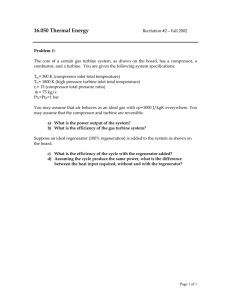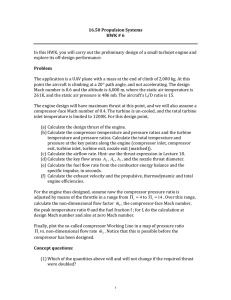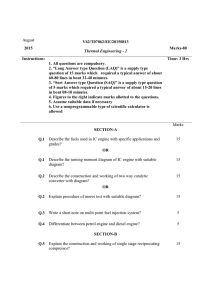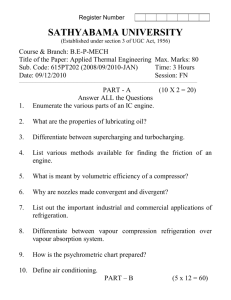2.61 Internal Combustion Engines
advertisement
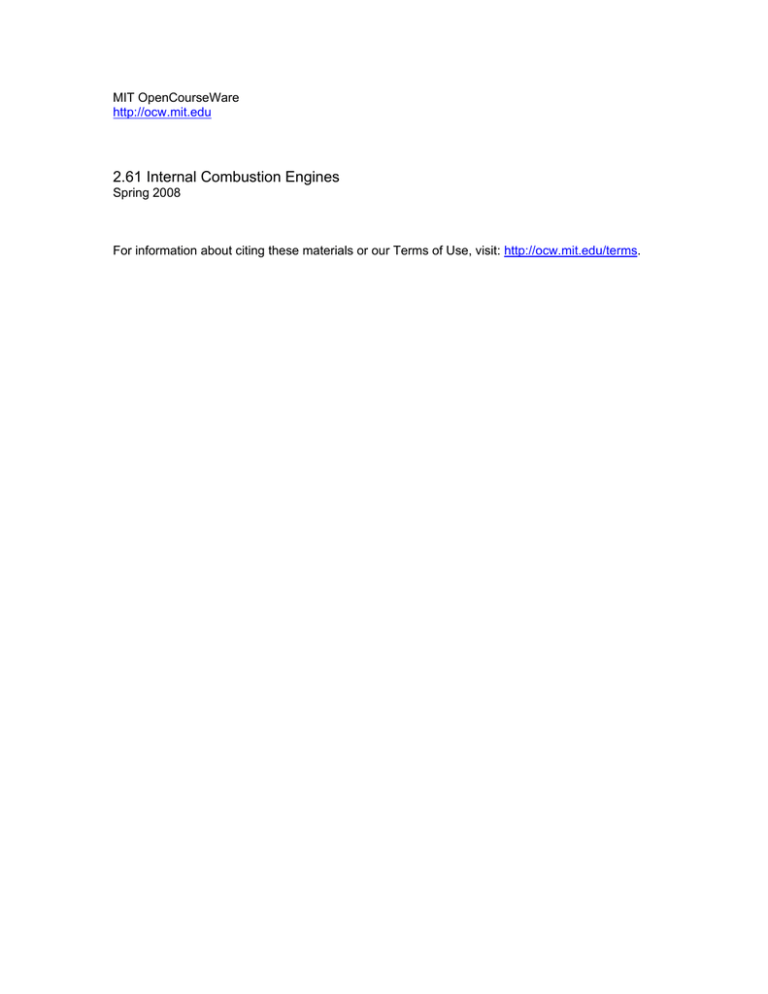
MIT OpenCourseWare http://ocw.mit.edu 2.61 Internal Combustion Engines Spring 2008 For information about citing these materials or our Terms of Use, visit: http://ocw.mit.edu/terms. 2.615 Internal Combustion Engine Final Examination - Spring, 2008 Open book, 3 hour Exam Problem 1 (20 points) (i) At engine operating temperature, automotive lubricants comprise long chain hydrocarbon molecules which are normally tangled up, but align themselves at high shear rates. Thus the viscosity decreases as the shear rate increases (shear- thinning). Explain why would this property help or hurt engine lubrication. (2 points) (ii) Experimentally, the frictional mean effective pressure (fmep) needed to overcome the valve train friction decreases with engine speed; e.g., see Fig. 13-24 of text. Explain this trend. (2 points) (iii) Synthetic diesel fuel (e.g. made by the Fischer Tropsch process which was invented in war time Germany to derive liquid fuel from coal and wood) has a very high cetane number (CN~80 compared to the normal diesel fuel with CN in the high 40’s). Give two comments on the impact of this high CN value on diesel engine design and operation. (2 points) (iv) An inventor proposed that a turbo-compound diesel engine be which uses an additional power turbine to extract mechanical energy out of the exhaust gas to the drive shaft. The novelty of the proposal was that much of the shaft power was to be derived from the power turbine instead of the engine. Give two comments on whether the concept is good or bad (each comment could either be positive or negative respectively). (2 points) (v) Give two reasons why retarding the spark timing at constant idle speed at cold start would make the catalyst to light-off faster. (2 points) (vi) Give two consequences from operating a SI engine on Miller cycle (i.e. with a configuration such that the compression ratio is less than the expansion ratio. (2 points) (vii) Give two reasons why for a given maximum power output of a SI engine, turbo-charging would lead to better fuel economy. (2 points) (viii) The US Army is interested in developing a diesel engine that does not use liquid coolant. T he primary reason for such an engine is the elimination of the radiator which is vulnerable at combat. Give two detrimental effects to the engine operation if such a configuration is used. (2 points) (ix) Why would one pursue a cylinder-deactivation strategy, i.e. deactivate some of the cylinders in certain part of the engine map? (1 point). Do you want to keep the valves open or closed for the deactivated cylinders and why (1 point). (x) One way to lower NOx emissions in diesel engines is to add water to the fuel. Since water is not mixable with diesel fuel, it has to been emulsified by a surfactant. Explain how it works and why this arrangement is more effective than injecting water in the intake manifold (2 points). Problem 2 (20 points) There has been substantial interest in using fuel cells as power sources in automobiles. The only practical reactants for current fuel cell systems are hydrogen and oxygen. It is difficult to use hydrogen directly in a vehicle because of the problems of storage and refueling. A proposed concept is to use gasoline as the fuel on-board and make hydrogen out of it. See press release below. Image removed due to copyright restrictions. Please see Akre, Brian S. "Chrysler Developing Electric Car Using Gasoline to Power Fuel Cell." Los Angeles Daily News, January 7, 1997. The method is to partially oxidize the fuel to CO and H2 first. Then the CO is reacted with the H2O (which is one of the end products in the exhaust) by the Water-Gas shift reaction to form H2 and CO2. The H2 is used in the fuel cell. You are to analyze the energetics of the process (i.e., energy balance analysis only; ignoring all the irreversibility losses). You may represent the gasoline as iso-octane and assume ideal reactions, i.e. the partial oxidation only forms CO and H2., and that all CO is converted to CO2 and H2 in the Water-Gas shift reaction. (a) On the basis of the energetics of the reactions, what is the maximum energy conversion efficiency of such a system? (b) How would your answer change if the fuel is not iso-octane but ethanol? (What is the major difference?) Problem 3 (20 points) To examine the behavior of turbocharging, we shall consider the following example of a four stroke 2.0 L displacement passenger car diesel engine turbocharged with a single stage centrifugal compressor, and a single stage turbine. For simplicity, there is no waste-gate and no inter-cooler. You may assume the following: • The ambient conditions are T1=300K and P1=1 bar. The working fluid may be assumed to have constant properties of γ = 1.35 and molecular weight of 29. • The turbine and compressor have constant efficiencies: ηt = 0.85 and ηc = 0.65. You may also assume that the Mach no. is small so that the kinetic energy of the fluid is negligible. • The compressor and turbine maps are shown in the accompanied figures. (For this simplified example, ignore the actual values of the ηc contours on the compressor map and assume ηc to be constant.) • The reference conditions of these maps are the same as the ambient conditions: Tref = T1; Pref= P1. • The engine volumetric efficiency based on the intake manifold condition is constant: ηv = 0.8. • The heating value of the diesel fuel is 43 MJ/kg. • Assume that 30% of the fuel energy is lost as heat transfer in the engine • The engine indicated net fuel conversion efficiency is ηf = 0.33 We shall look at the engine operating at 3000 rpm with A/F ratio = 22, and compressor pressure ratio (πc) of 1.5. (a) What is the compressor outlet temperatures (T2) at compressor pressure ratios πc = 1.5? (b) What is the engine intake air mass flow rate at this value of πc? (c) What is the compressor speed at this value of πc? (d) Draw on the compressor map the operating point corresponding to your answers of (b). (e) What is the corresponding turbine inlet temperature? (f) What is the turbine pressure ratio (πt)-1 that is required to power the compressor? (Assume that all mechanical losses are already incorporated into the definition of the compressor/turbine efficiencies.) (g) The turbine and compressor run at the same speed. From the turbine map, using the result of (f), determine the mass flow rate required by the turbine to power the compressor. (h) Put this point also on the compressor map; i.e. plot the mass flow rate required by the turbine versus the compressor pressure ratio πc. Does this point match up to the point plotted in part (d)? c c cc c c c 3.4 7250 6960 3.0 72% 2.8 70% 2.6 2.0 75% 1.6 Ignore η6070 c contours. Assume η 5550 c = 0.65 everywhere 4840 1.4 1.2 1.0 65% 60% it 2.2 1.8 Simple turbo-charged diesel engine 6530 74% 2.4 Su rg el im Pressure ratio Pressure ratio πc 3.2 2650 Compressor orpressor ssor Compressor 4025 N/ssor T1Map Map 0 0.5 1.0 1.5 2.0 2.5 3.0 3.5 4.0 4.5 5.0 5.5 . "Corrected" Flow rate m T1/P1 corrected m Corrected mass flowrate , kg/s Correctedc mass flowrate m , kg/s corrected orrected Figure by MIT OpenCourseWare. Adapted from Haddad, Sam David, and Watson, . .. N. Principles and Performance in Diesel Engineering N. Principles and Performance in Diesel Engineering. Chichester, England: Ellis Horwood, 1984. -1 -1 (π(π =P3/P4 =P3/P4 t) t)=P3/P4 ref Pref=1Pbar T ref re Tref = 300K Turbine Tu rbineMap Map Turbine N/√(T3/Tref)


